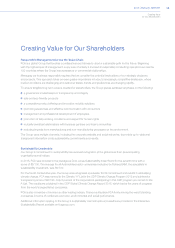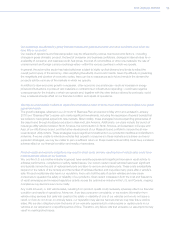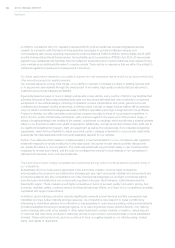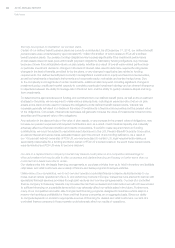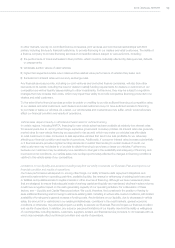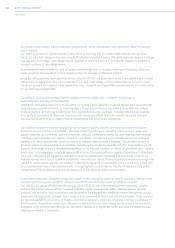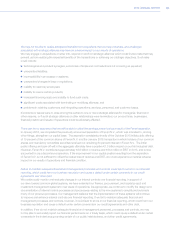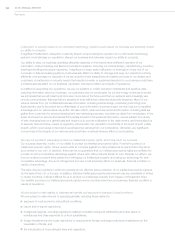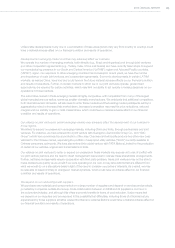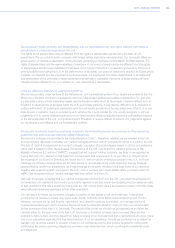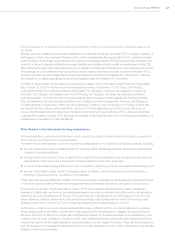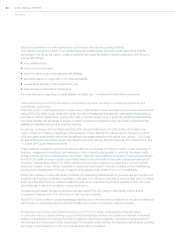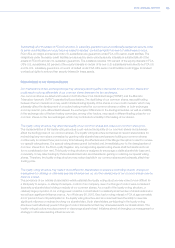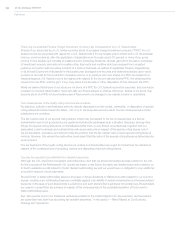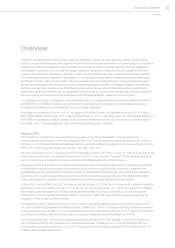Chrysler 2015 Annual Report Download - page 23
Download and view the complete annual report
Please find page 23 of the 2015 Chrysler annual report below. You can navigate through the pages in the report by either clicking on the pages listed below, or by using the keyword search tool below to find specific information within the annual report.
2015 | ANNUAL REPORT 23
Unfavorable developments in any one or a combination of these areas (which may vary from country to country) could
have a material adverse effect on our financial condition and results of operations.
Developments in emerging market countries may adversely affect our business.
We operate in a number of emerging markets, both directly (e.g., Brazil and Argentina) and through joint ventures
and other cooperation agreements (e.g., Turkey, India, China and Russia) and have recently taken steps to expand
our manufacturing presence in our South and Central America (“LATAM”) region and Asia and Pacific countries
(“APAC”) region. Our exposure to other emerging countries has increased in recent years, as have the number
and importance of such joint ventures and cooperation agreements. Economic developments in certain LATAM
markets, as well as China, have had and could have in the future material adverse effects on our financial condition
and results of operations. Further, in certain markets in which we or our joint ventures operate, government
approval may be required for certain activities, which may limit our ability to act quickly in making decisions on our
operations in those markets.
The automotive market in these emerging markets is highly competitive, with competition from many of the largest
global manufacturers as well as numerous smaller domestic manufacturers. We anticipate that additional competitors,
both international and domestic, will also seek to enter these markets and that existing market participants will try to
aggressively protect or increase their market share. Increased competition may result in price reductions, reduced
margins and our inability to gain or hold market share, which could have a material adverse effect on our financial
condition and results of operations.
Our reliance on joint ventures in certain emerging markets may adversely affect the development of our business in
those regions.
We intend to expand our presence in emerging markets, including China and India, through partnerships and joint
ventures. For instance, we have entered into a joint venture with Guangzhou Automobile Group Co., Ltd (“GAC
Group”) which has commenced local production of the Jeep Cherokee and will locally produce two other new Jeep
vehicles for the Chinese market, expanding the portfolio of Jeep sport utility vehicles (“SUVs”) currently available to
Chinese consumers as imports. We have also entered into a joint venture with TATA Motors Limited for the production
of certain of our vehicles, engines and transmissions in India.
Our reliance on joint ventures to enter or expand our presence in these markets may expose us to risk of conflict with
our joint venture partners and the need to divert management resources to oversee these shareholder arrangements.
Further, as these arrangements require cooperation with third party partners, these joint ventures may not be able to
make decisions as quickly as we would if we were operating on our own or may take actions that are different from
what we would do on a standalone basis in light of the need to consider our partners’ interests. As a result, we may
be less able to respond timely to changes in market dynamics, which could have an adverse effect on our financial
condition and results of operations.
We depend on our relationships with suppliers.
We purchase raw materials and components from a large number of suppliers and depend on services and products
provided by companies outside the Group. Close collaboration between an OEM and its suppliers is common in
the automotive industry, and although this offers economic benefits in terms of cost reduction, it also means that
we depend on our suppliers and are exposed to the possibility that difficulties, including those of a financial nature,
experienced by those suppliers (whether caused by internal or external factors) could have a material adverse effect on
our financial condition and results of operations.


